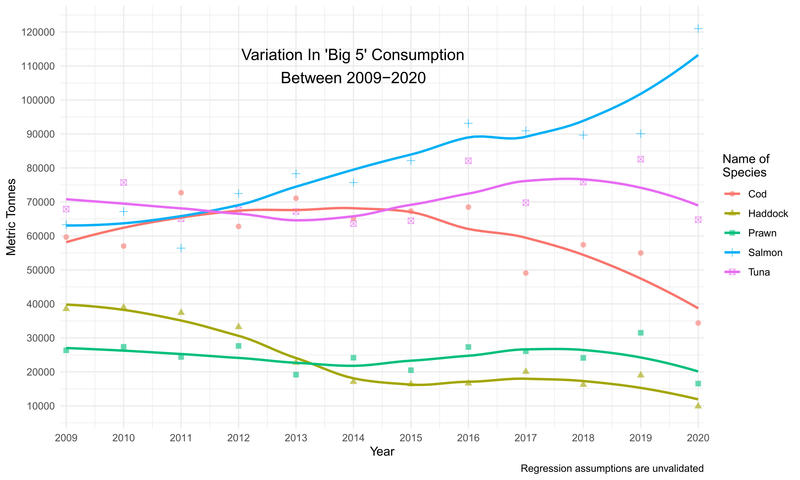Fragile seafood systems, diversity and demand: A UK case study

Fragile seafood systems, diversity and demand: A UK case study
Date posted: 14 November 2025
This post was written by Kai Siderman-Wolter
The United Kingdom (UK) is largely self-sufficient in most foods, with domestic production meeting domestic demand, particularly for beef, lamb, wheat and potatoes1. However, the same cannot be said for fish. Despite being an island nation, the UK is a net importer of fish, meaning we import more fish than we export. Most of these imports are dominated by just five species: cod, haddock, prawns, salmon, and tuna, known as the 'Big 5' and making up around 80% of all fish consumed in the UK2. Consumption of the Big 5 has been relative consistent since 2009, but declines in all species have been noted in more recent years, with the exception of salmon (Figure 1).

Figure 1. Total UK consumption (tonnes) of the 'Big 5#, 2009-2020
The UK's dependency on imported fish for domestic consumption exposes the food system to a range of external risks. For example, changes in trade agreements and tariffs3 can disrupt supply, and even bigger longer-term risks from climate change could impact fish stocks, placing increased pressure on the fish supply chain4. Climate change is not affecting all species or regions equally - some are hit harder than others4. For example, warming water temperatures, irregular rainfall and prolonged dry seasons has significantly impacted shrimp farming in Vietnam5,6. Vietnam is the largest exported of prawns to the UK, exporting 18,000 tonnes in 2022 alone7. In other words, climatic changes thousands of miles away could impact what ends up on UK plates. Far from an issue limited to just Vietnam, many of the UK's Big 5 suppliers face heightened risks from climate change, particularly tropical and small island developing states are among the most vulnerable to declining fish stocks8. This is concerning, given the UK reliance on these countries for imports. The largest prawn and tuna suppliers to the UK are Vietnam, India, Ecuador, the Maldives and Seychelles respectively7.
The UK's heavy reliance on vulnerable foreign suppliers highlights just how fragile its seafood system really is. This dependence poses a serious risk to food security, especially at a time when fish is being promoted not only for its nutritional benefits3 but also for its lower carbon footprint compared to red meat and other animal proteins9. Therefore, diversifying domestic seafood consumption is vital. By broadening the range of species eaten in the UK, we can lessen the country's exposure to climate-related shocks overseas, and build a more resilient food system.
Small pelagic fish, like herring and mackerel, are the most produced fish in the UK, with net exports of 39,200 and 54,800 tonnes respectively (Figure 2). Not only do small pelagic fish have the lowest greenhouse gas emissions across all seafood groups10, but through encouraging consumption of locally caught pelagic fish, the UK could strengthen food security through diversification, reduce reliance on imports, and cut the environmental impact of its seafood system. We must encourage policymakers to enable this dietary shift, while ensuring consumers are provided with clear, accessible information on the benefits of choosing local fish.

Figure 2. Crude trade gap (tonnes) for the 'Big 5' and the five most exported fish species. Values averaged over five years between 2015 and 2019.
Kai Siderman-Wolter is a first year Geography student at Mansfield College, Oxford. This blog was supported by his Crankstart Scholar Internship at the Oxford Martin School, which aims to support students from low-income backgrounds. Kai explored fish consumption in the UK and the benefits of increasing consumption. This project highlighted the advantages of diversifying the fish eaten from both a health and climate change perspective. Kai learnt about the interesting ways in which fish can be incorporated into a more climate friendly future, the caveats to this, and the ways fish can support a healthier diet to improve social wellbeing.
References
1. United Kingdom Food Security Report 2021: Theme 2: Uk Food Supply Sources. https://www.gov.uk/government/statistics/united-kingdom-food-security-re...
2. Harrison, L.O.J., Engelhard, G.H., Thurstan, R.H., and Sturrock, A.M. Widening mismatch between UK seafood production and consumer demand: a 120-year perspective. Rev Fish Biol Fisheries 33, 1387-1408 (2023).
3. Lofstedt, A., Scheliga, B., Aceves-Martins, M., and de Roos, B. Seafood supply mapping reveals production and consumption mismatches and large dietary nutrient losses through exports in the United Kingdom. Nat Food 6, 244-252 (2025).
4. Nuon, V. et al. Climate change drives contrasting shifts in fish species distribution in the Mekong Basin. Ecological Indicators 150, 111857 (2024).
5. Do, H.-L., and Ho, T.Q. Climate change adaptation strategies and shrimp aquaculture: Empirical evidence from the Mekong Delta of Vietnam. Ecological Economics 196, 107411 (2022).
6. Nadarajah, S., and Eide, A. Are Asian fresh and brackish water aquaculture production vulnerable or resilient towards climate change impacts? Aquaculture Economics & Management 24, 232-254 (2020).
7. UK sea fisheries annual statistics report 2022. https://www.gov.uk/government/statistics/uk-sea-fisheries-annual-statist... (2023).
8. Nash, K.L. et al. Trade and foreign fishing mediate global marine nutrient supply. Proceedings of the National Academy of Sciences 119, e2120817119 (2022).
9. Bianchi, M. et al. Assessing seafood nutritional diversity together with climate impacts informs more comprehensive dietary advice. Commun Earth Environ 3, 188 (2022).
10. WWF. Risky seafood business understanding the global footprint of the UK's seafood consumption summary report (2022).














